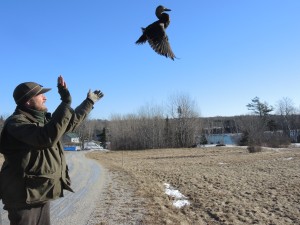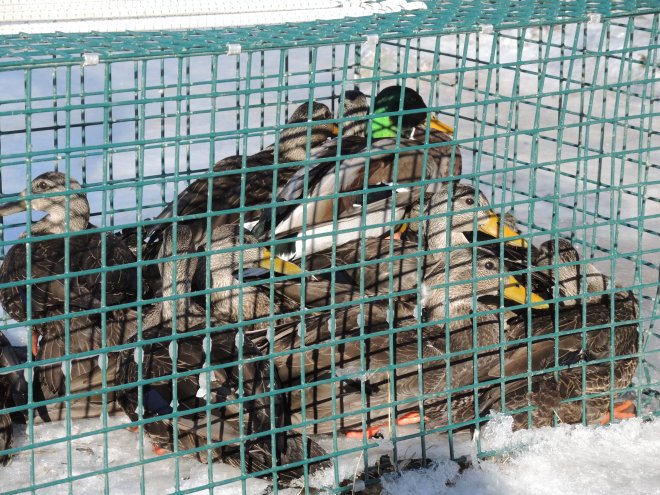
The numbered band on this duck will allow biologists to track this duck and provide valuable information on such things as migration routes and mortality.
Temperatures in the single digits coupled with winds in the double digits put the windchill at the other side of zero. You know that expression, “The weather’s great…If you are a duck” certainly was in play this day.
While I hid underneath multiple layers of wool, polypropylene and down; out in the surf, black ducks were bobbing up and down with the whitecaps, enjoying the relative warmth of the slushy water.

These black ducks were attracted inside the funneled fencing looking for corn. Biologists set the traps when the weather is cold and other food sources are covered in ice and snow.
As winter tightens its grip, food for ducks becomes scarce, covered under blankets of snow and ice. Biologists use winter’s hold to their advantage, luring ducks into funneled, fenced enclosures with whole kernel corn in order to band them and learn more about them.
In Maine, biologists with Maine Fish and Wildlife and US Fish and Wildlife aim to band about 500 black ducks each season. Banding and the subsequent reporting of bands allows biologists to monitor survival, harvest rates, movements and reproductive rates.
Returns on banding show that the black duck population appears to be stable in their core area after a period of decline. At the periphery of their range the population is not as stable. Much of the original decline was traced to the loss of breeding grounds and wintering habitat. Black ducks are ground nesters that breed in salt marshes, beaver flowages, wetlands and boreal forests.

Once inside the fencing, the ducks are led into a smaller crate, and they are then removed in order to place a band on their leg.
Black ducks banded in Maine have been reported as far south as Maryland, by contrast, mallard ducks banded in Maine have been found as far west as the great lakes and even Kansas, and as far south as South Carolina.
On this day, I accompanied IFW wildlife biologist Kelsey Sullivan, who oversees the department’s waterfowl banding
program. Along with volunteer Houston Cady, the duo banded nearly 50 black ducks. As they band, they record the sex of the bird, the species, and whether it is an adult or was born this past summer.
The birds were about equally split between adults and juveniles, and we did band one mallard along with the black ducks. Interestingly, we also banded a mallard/black duck hybrid, which seem to be more common in other states further south.
We visited three different sites with traps… all had birds, some more than others. Before setting the traps, Kelsey will spread corn for several days to get birds accustomed to coming to the spot. He chose his spots carefully, southerly facing for sun, and near running water, usually a small brook. The two factors together seem to be attractive to ducks.

Whole kernel corn is placed leading up to the enclosure as well as inside in order to attract the ducks.
After about a week, Kelsey set the fencing trap to coincide with the high lunar tides. The ducks had become quite comfortable with the fencing and food, and when we came the next morning, there were over a dozen ducks in each trap, ready to be banded and added to Maine’s contribution to the interstate and Canadian waterfowl banding program.


